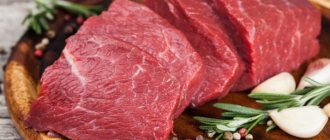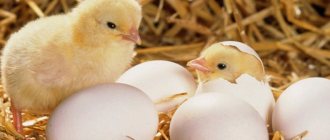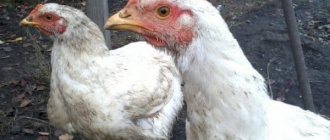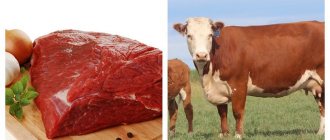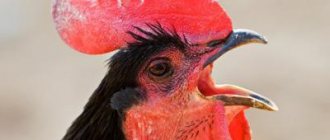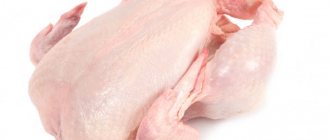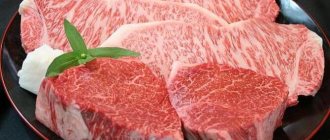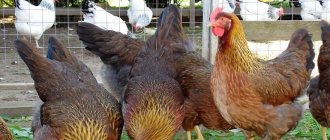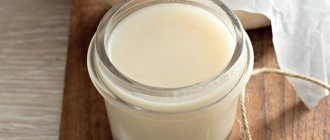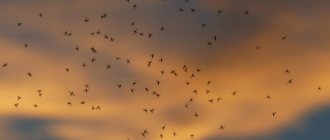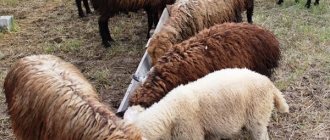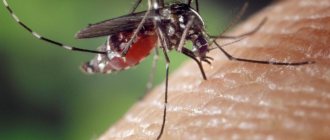Good afternoon, birders and random blog guests! Why do broilers have green breasts in their carcasses? The reasons for obtaining green meat from broilers, according to veterinarians, are in our material. American poultry farmers were the first to encounter green poultry meat.
We are talking about “green muscle disease” or polyetiological pathology. The root cause of the problem is injury! It is associated with weight gain and uneven development of connective tissue and muscle parenchyma of the thoracic region.
According to Russian scientists (I.M. Shchetinsky, L.M. Lyakhovich, etc.), the problem under consideration is a pathological anomaly provoked by ischemia of the sternum muscles. In turn, ischemia is the result of the fact that the muscles do not receive enough nutrients, minerals and oxygen due to insufficient blood supply. This “diet” ends in atrophy, dystrophy and necrosis.
Why do broilers have green breasts?
Broiler meat turns green due to hemorrhages in areas affected by ischemia.
Improved meat productivity indicators have caused hypertrophy of the pectoral muscles of modern cross-breed broilers. At the same time, selection techniques did not affect other muscles, the bones of the wings - against the background of the sternum they look underdeveloped. All this together limits the movement of the bird at the end of fattening.
In addition to Oregon disease, the group of somatic ailments includes:
- Weakness of the limbs. In this case the bird is said to fall on its feet;
- white muscle pathology;
- cellulite.
The first two problems are the result of failures in the cell's antioxidant systems caused by selenium deficiency. Poultry farmers usually encounter such diseases when raising young animals.
In America, the first large-scale necrotic processes that make meat green were discovered in turkeys. Pathological changes:
- Swelling and pallor of the deep pectoral muscles;
- thinned and dull fascia;
- development of necrosis in edematous areas.
Later, such a picture was revealed in broilers. At the same time, green breast in broilers was more common in males. Since the problem does not appear externally, low-quality meat ended up on the shelves of retail outlets, although it was immediately rejected.
In Kharkov, meat from 45-50-day-old meat chickens was studied.
Changes have been identified that occur in disorders such as hepatodystrophy and serous-hemorrhagic cuticulitis. Features of muscle tissue of problem carcasses:
- Shape – oval-elongated in places;
- color – grayish-yellow, and greenish at the edges;
- consistency – loose;
- the presence of hemorrhages at the border between healthy and altered muscle tissue.
All these are companions that accompany acute necrosis, in which a demarcation inflammatory process occurs.
In samples affected by necrosis, iron-containing pigments were found that are formed during the breakdown of hemoglobin and red blood cells. These changes led scientists to conclude that they were dealing with a traumatic illness.
Content
Bank chickens are considered more decorative. They are easy to tame, and keeping a jungle bank fowl at home is not considered very difficult. This breed needs large enclosures, as they will feel uncomfortable in a small one. The space is measured based on 2-4 sq.m. per chicken. chicken coop. In a small territory they will be able to get along if there is only a male there, since two or more will constantly fight for a small territory.
In order for the chickens to be able to fly, the height of the pen must be at least 4-5 meters, and it is better to cover the top with a net.
If it is not possible to make such an enclosure, it is recommended to trim the feathers for the safety of the chickens.
In the enclosure you need to come up with a place for the chickens to sleep. It is best if it is a tree, at least a small one. This breed takes a very long time to get used to a regular roost. It is also necessary to make a covered room for the chickens.
Green meat from broilers, what is it?
It turns out that in one group of broilers there were a couple of pathologies:
- Firstly. The bird is in the first stage of growing. White muscle disease, which affects the muscles of the chest, thighs and heart.
- Secondly. Final fattening. Green breast in broilers - green muscle disease - acute or chronic alternative myopathy.
Experts say green breast muscle is the result of metabolic disorders in chickens produced from chickens whose diets were low in selenium and other antioxidants.
Appearance
Small bird. The length of the male is 66 cm, weight 900-1250 g; the female’s weight is 500-750 g. The male’s color is reddish-golden on the dorsal side, blackish-brown on the ventral side. The feathers on the head, neck, back of the head and on the upper side of the tail are golden yellow. The back is purple-brown, the chest and tail feathers are black-green, the wings are brown. The comb on the head is red, the beak is brownish. Legs slate black. The female is smaller than the male, has a shorter tail and is distinguished by a less bright, brownish color: her neck feathers are black with yellow edges, the underside of the body is dirty brown with lighter spots on the feather shafts, the back is brownish-gray.
Green breast in broilers: prevention of green muscle disease
Preventive measures in our case are based on compliance with feeding technology and the use of selenium preparations. The action of this mineral is similar to the work of vitamin E. But the activity of the antioxidant protein part of the former is hundreds of times higher than the antioxidant activity of the latter.
A deficiency of these elements provokes the most dangerous pathologies. These include exudative and hemorrhagic diathesis, white muscle disease, embryonic dystrophy and others.
Effects of drugs containing selenium and vitamin E:
- Modeling IC;
- stimulating growth;
- regulating the functioning of the immune system;
- antioxidant;
- anti-stress.
Indications for the use of veterinary drugs based on microelements and vitamin “youth”:
- Retarded growth and development;
- problems with the reproductive system;
- white muscle disease and green muscle disease;
- cardiopathy and traumatic myositis;
- toxic liver dystrophy;
- invasions and infections;
- stressful condition.
What bird is similar to a chicken?
In total, there are 250-263 species of chickens on our planet, so it will not be possible to consider everything. The chicken order includes 5 families:
- Hoatzins. They live in South America.
- Weed chickens. They live in Australia, Polynesia, Indonesia.
- Tree chickens.
- Pheasants. The most common family that has “representatives” in almost all countries of the world. There are 174 species, 12 of which can be found in Russia.
- Grouse.
All representatives of these families resemble each other to one degree or another. But most of all our pets are pheasants. These birds are most similar to chickens.
Wild chicken is closest to domestic chicken. The only significant difference between these species is their lifestyle. The living conditions of jungle birds are much more difficult, so they have to survive. Pets practically live in heaven. This is the main difference between them. And genetically they are very similar, so much so that they can produce fertile offspring.
0 0 votes
Article rating
Can you eat green meat in chicken breast?
The green breast of broilers will not bring harm to us. But no one will eat such chicken. Do you agree that this is disgusting?
Now we know why broilers have green breasts. These are injuries and unbalanced nutrition of broiler chickens.
Please like and rate our explanation.
Subscribe to the channel “Chicken”, it’s interesting with us!
See you later, colleagues! We have a lot of useful information ahead.
Deep pectoral myopathy (DPM) is a degenerative muscle disease in birds, often called green muscle disease. This disease is a hidden problem in broiler chickens that is not discovered until the birds are brought to the processing plant. It is characterized by necrosis and atrophy of the deep pectoral muscles, often called chest wall disease (Bilgili and Hess, 2008). Green muscle disease is not a new disease, but has become quite common in meat-type broilers that have been bred to have a higher amount of breast meat.
The disease was first described by Dickinson et al. (1968) in adult turkeys. Later, Page and Fletcher (1975) noted this disease in broilers, and later Richardson (1980) noted this disease in young animals. As the number of broilers sold as heavy weights for further processing increased, reports of DPM began to increase. According to some researchers (Bilgili et al., 2000), this condition is becoming more common in male birds than in female birds. However, there is some disagreement on this issue (Lian et al., 2012). The problem is also observed in free-range broilers.
What causes this problem?
A reduction in fillet size and the muscles responsible for moving the wings up and down are thought to be responsible for this problem. These large (breast fillet) and small pectoral muscles make up the largest portion of all muscles that are involved in flight. Even though poultry does not fly, these muscles are still involved in wing movement (Bilgili and Hess, 2002). It is generally accepted that DPM is the result of a restricted blood supply that develops in the small pectoral muscles, the tender, mostly due to the fact that the tender is surrounded by a stiff, inelastic muscle or membrane and the sternum. As a result, the tender's muscle mass cannot increase in response to physiological changes that occur when the muscles are engaged in movement, such as wing movement (Iordana and Pattison, 1998).
Martindale (1979) indicated that when the wing is physically loaded, tenders increase in mass by up to 20%, due to increased blood circulation in the muscle. The tender is unable to expand due to being trapped between the sternum and the rigid membrane, the increased weight puts pressure on the tender and the blood supply to the muscle contracts and/or stops. This creates an oxygen deficiency, which causes necrosis or localized death of cells and tissue due to lack of blood supply.
Increased activity in birds that results in wing movement is most likely the main cause of green muscle disease. However, there are a number of factors that act individually or possibly together to cause increased wing movement. These factors include:
- The speed at which the poultry farmer walks around the coop or picks up dead birds
- Dimming (gradual increase/decrease of light levels)
- Light intensity in the coop and lighting program used
- Level of bird activity in the coop a few days before capture
- Number and duration of feed outages (equipment malfunctions or feed related issues)
- Feed withdrawal program
- Excessive noise that scares birds (running a lawnmower close to the coop)
- Handling birds during catching
Even though the condition is called green muscle disease, it takes several days of intense wing flapping before the muscles actually turn green. When the fibers are directly damaged, the muscle becomes red and there may be hemorrhage in the muscle due to ruptured tender vessels. If observed in a processing plant, the condition is often associated with fishing (increased activity) and can last up to 48 hours. After initial appearance and after several days, the tender gradually becomes discolored and appears necrotic. This initial area of bruising often appears in the middle of the tender, but can extend to nearly the entire tender (or perhaps two). After some time (perhaps a week or more), the tender becomes a characteristic green color - this is what gave the name to the disease. The green color results from the gradual breakdown of hemoglobin and myoglobin in damaged muscle tissue.
What can be done?
This condition is currently a very serious problem in the poultry industry, particularly because it has no impact on the health of the birds and is therefore usually not detected by the poultry farmer until the broiler reaches the processing plant. Additionally, this condition may either partially or completely affect one or two tenders. It has proven very difficult to predict whether or how many green tenders will show up in a flock during processing. However, green tenders are never seen by the public as they are removed during recycling. This creates an economic loss for the industry due to the fact that the disease affects the most valuable part of the skeleton (the breast) (Bianchi et al., 2006). While the number of birds found to have green muscle disease is quite small compared to the total number of birds processed, the number is still increasing and indicates that the incidence of the disease may continue to increase as brisket continues to grow. be the most important meat for broilers.
Management practices that minimize the occurrence of wing flapping appear to be the best defense against the disease. A limited amount of time spent in the coop should not affect the attitude towards the flock. You should check the birds regularly, check equipment, remove dead birds and monitor ventilation, air quality, temperature, ammonia levels, droppings, and so on. Excessive activity that could lead to unwanted wing flapping should be avoided. Walk slowly around the coop when checking birds, removing dead birds, or checking equipment. Be especially careful near fences where large numbers of birds tend to congregate, especially not to enter too quickly or abruptly.
Keep noise levels both inside and outside the coop to a minimum because they can frighten the birds, especially if you have a shy flock that is already quite sensitive. This may mean it may be worth holding off on cutting the grass for a few days to avoid scaring the birds. Work with minimal lighting that will allow you to do all the necessary work (picking up dead birds, checking equipment, repairs, etc.) in the coop. Birds will respond to increased light levels by increasing activity. Therefore, avoid sudden transitions from one light level in the coop to another. Use the sunset/sunrise function if your dimmer has one, or increase the light level partly rather than all at once.
conclusions
Green muscle disease is becoming increasingly common in poultry production, especially in broilers raised at higher weights for further processing. It is characterized by necrosis and atrophy of the pectoral muscles and is thought to be associated with increased bird activity and increased wing flapping in the days (possibly weeks) before capture. This is truly a problem for the industry, since the disease has no effect on the health of the birds and often goes unnoticed and can only be detected during processing. Management techniques that reduce or minimize wing flapping are the best means of preventing the development of this disease.
Fig. 1 Pale green small pectoral muscles.
Green meat disease, or “green muscle disease,” was first officially recorded in the US state of Oregon. This is a polyetiological disease (caused by several factors), developing as a result of self-traumatization of the bird with an increase in body weight and asynchronous development of connective tissue and parenchymal elements of the pectoral muscles.
As clarified by scientists of the Kharkov State Veterinary Academy I.M. Shchetinsky, A.V. Zakharyev, A.Yu. Ulyanitskaya, L.M. Lyakhovich, green meat is a pathology that develops with significant ischemia of the pectoral muscles due to their insufficient blood supply, which leads to the development of atrophy, dystrophy and necrosis. Insufficiency of the supporting functions of connective tissues leads to microtrauma of blood vessels in the muscles when the bird makes sudden movements. It is hemorrhages in areas affected by ischemia that explain the green color of broiler meat.
In modern broiler crosses, the superficial pectoral muscles are significantly increased in size, while other muscles and bones of the pectoral limbs are relatively poorly developed. Because of this, at the final stage of cultivation, some individuals lose the ability to move freely.
Green chicken meat, or Oregon broiler disease, is not the only medical disease that affects these birds. Thus, broilers may suffer from “broiler limb weakness”, when broilers fall on their feet, “white muscle disease”, “broiler cellulitis”. Limb weakness and white muscle disease in broilers are caused by disruption of the cell's antioxidant systems due to selenium deficiency, which is usually observed in the first days of a bird's life.
In the USA, the first green volumetric necrosis in the pectoral muscles was discovered in turkeys. At the same time, the deep pectoral muscles swelled and became pale, the fascia became thinner and dull, necrosis developed at the site of muscle swelling, and in some places the necrotic mass took on a green color. Later, green meat began to be discovered in the chicken breast of broilers, and this pathology was more common in roosters than in hens. And since it was impossible to determine from appearance whether the meat inside was of high quality or not, entire batches of broiler meat were returned from retail chains.
Kharkov scientists studied this pathology on the pectoral muscles of broiler chicken carcasses at slaughter at 45-50 days of age. Pathomorphological analysis of the affected areas revealed changes characteristic of hepatodystrophy and serous-hemorrhagic cuticulitis. When cutting the pectoral muscles in five carcasses, the presence of foci of muscle tissue of an oval-elongated shape, gray-yellow, greenish at the edges, loose consistency, partially delimited from macroscopically unchanged tissue by a strip of hyperemic tissue in which single hemorrhages are noticeable, was discovered. These changes are characteristic of acute necrosis with the development of demarcation inflammation (local acute alternative myopathy).
In all samples, the accumulation of iron-containing pigments, products of the breakdown of erythrocyte hemoglobin, was found in the necrotic mass. Vascular pathologies, the presence of iron-containing pigments, and the presence of free sulfated glycosaminoglycans in the connective tissue indicate a traumatic origin of this disease.
Thus, in the same batch of birds, two pathologies were identified, which, in fact, in etiology, are variants of alternative myopathy. In broiler chickens in the first weeks of life, “white muscle disease” has been established, affecting the heart muscle, pectoral and thigh muscles. In broiler chickens at the final stage of rearing, “green muscle disease” was discovered, which is an acute alternative myopathy and cases of chronic myopathy with the development of focal postnecrotic sclerosis.
According to experts, this pathology (green meat in chicken breast) is based on metabolic disorders in young poultry associated with a lack of selenium and other antioxidants in the diet of the parent poultry, with the further development of “white muscle disease” in chickens during the first days of life, which is the cause the tendency of broilers to develop green meat.
Based on the materials of the article “Green Pathology”, magazine “Healthy Animals and Lives”, 06/2017 (No. 186) Tatyana Kuzmenko, member of the editorial board Correspondent of the online publication “AtmAgro. Agroindustrial Bulletin"
How useful was the information for you?
The instinct of wild ancestors and domestic chickens
The massive use of chickens as a source of eggs and meat became possible due to the organization of the flock and the peculiarities of nesting behavior.
The domestic chicken retains the following instincts, which once helped domesticate the wild birds of South Asia:
Pack organization
When chickens reach the stage of changing from down to feathers, they develop secondary sexual characteristics. After a couple of months, the cockerels begin to have fights, as a result of which the dominant individual is determined. This allows people to use "extra" roosters for meat.
The breeder and keeper will be one rooster per ten hens. But as a result of natural selection, the most aggressive rooster remains, which people do not always like. Often the most pugnacious rooster is sent for meat, which defends its harem from people. All that remains is to “lead” the harem by a rooster of moderate mood.
Lack of migration instinct
There is enough food in the jungle all year round, so there is no point in wild chickens flying to other lands. The lack of desire to change places creates the stability of the flock, as a result of which the chickens, even with wild grazing in the yard and on the street, do not go far from the chicken coop.
Sophisticated voice control system for flock and chicks
She once helped keep chickens at the “self-government” level. A person only needs to take a closer look, and most importantly, listen to what the chickens are doing in order to understand which individuals will conscientiously breed chickens and which are incapable of such complex behavior.
Vocal data of roosters
Morning crowing has become an element of the culture of many peoples, which is captured in fairy tales and legends. The crow of a rooster drives away evil spirits and announces the sunrise. For chickens, this signal is like the sound of a bugle that gathers soldiers into formation.
After the rooster crows in the morning, the flock must not only wake up: the chickens must gather around their vociferous leader. Roosters with a good voice could gather many hens around them, which contributed to the transmission of vocal genes from generation to generation.
Hatchery breeding of chickens leads to the degeneration of their instinctive base. For this reason, new breeds are not formed in cage conditions.
Preservation of the instincts of wild ancestors is an indicator of the integrity of the genome of domestic chicken, which is a condition for good health and resistance to environmental influences.
The broiler has green meat in its breast.
When cutting a broiler, I found greens in the meat. The broiler has green meat in its breast.
Broiler 3 months. Scored. When cutting, there is some greenery in the breast. What could it be? Is it possible to eat such meat?
- Quote
- answer
Maybe a blow or bruise?
- quote
- answer
I'm interested in this too.
- quote
- answer
You need to go to the vet. “Maybe” is inappropriate.
- quote
- answer
Brazilian fever. Eating is strictly forbidden. When cutting a carcass, if there are cuts, abrasions, or sores on the hands, the person is charged. Lethal outcome in 99% of cases.
- quote
- answer
You've really caused a nightmare) Let him take the carcass to the veterinarian.
- quote
- answer
No, why. This is a new mutated virus.
- quote
- answer
It’s almost like Ebola, especially to the doctor.
- quote
- answer
Maybe you're right. I took a risk and gave it to the dog. She screamed. Buried it.
- quote
- answer
Where were they buried? In your yard? She needed to be burned. To stop the virus.
- quote
- answer
Made me laugh heartily.
Green meat is myopothia, the death of muscle fibers. Broilers are genetically unable to live long, healthy lives. Due to high weight and age, gradual death and degeneration of muscle fibers occurs.
- quote
- answer
Cut out the green meat and eat the rest.
- quote
- answer
- quote
- answer
White stripes on the meat. The defect may vary in size of the visible streaks from less than 1 mm to over 2 mm in width. The prevalence of this defect in some herds can exceed 12 percent, and the defect is visible on the fillet (pectoralis major muscle). The prevalence of “white markings” directly correlates with high weight for age and is typical for broilers weighing over 3.5 kg. On microscopic examination, the affected muscles show deposits of adipose tissue, displacing damaged muscle fibers, resulting in characteristic visible changes. Unlike normal tissue, its moisture content is slightly lower and protein levels are significantly reduced, but these losses are compensated by higher levels of fat and collagen, which are deposited to the detriment of muscle tissue. The fatty acid composition of large white fillet meat is higher in monounsaturated fatty acids and lower in polyunsaturated fatty acids. In particular, eicosapentaenoic acid (EPA) and docosahexaenoic acid (DHA) levels are significantly lower compared to unaffected muscle tissue. Increasing the content of EPA and DHA in feed is ameliorative. The positive effect of supplementing the diet with vitamin E, selenium and sulfur-containing amino acids has not yet been demonstrated.
"Wooden" breast. This is an inflammatory disease in which the breast muscles are pale in color and have a noticeably firmer texture. In this condition, capillaries within the fascia surrounding the muscle bundles are constricted by hypertrophied muscle fibers, resulting in decreased vascularity and increased diffusion distances. Microscopic examination of tissue in cases of "wooden breast" shows a basophilic staining response, indicating myodegeneration. There is no bacterial participation in the inflammatory process; it is entirely related to hypoxia. In the field, improvement in this type of defect follows administration of vitamin E and biocomplex selenium. There is evidence that increasing arginine in the diet is quite beneficial.
Green muscle disease. This process is characteristic of the pectoralis minor muscle and is also called deep pectoral myopathy. Myodegeneration is associated with excessive muscle activity when broilers flap their wings excessively. The condition is apparently aggravated by body type, which promotes hypertrophy of the pectoral muscles. Greening of the muscles can occur at any age, although it only becomes apparent when the meat is separated from the bones or when whole carcasses are roasted at the time of cutting. Prevention includes maintaining proper light intensity, keeping house noise levels low, and avoiding excessive movement and agitation. Supplementing the diet with antioxidants and organic selenium may improve the situation.
Craniospinal myopathy. The defect was first identified in 2002 in Brazil. Since 2007, its presence has been reported in approximately 0.5 percent of carcasses. The latissimus dorsi muscle contains slow-oxidizing type I fibers that fatigue slowly but are dependent on oxygen. Roosters are more susceptible to the defect, especially those with a body weight of 2.5 kg and above, and there is a strain dependence.
Hi all. We bought broiler chicken at the market, and when cutting it, a piece of green meat was found... I’ve never seen anything like this in my life
it was like bones
Did you know that the Sperm Whale auction helps you save money? Try it.
19 minutes left
12 minutes left
11 minutes left
6 minutes left
Other representatives of the genus
Other wild birds of southern Asia and surrounding islands have some differences in phenotype, but their behavior and lifestyle are very similar. This is evidenced by the comparative description of the three types of “savages”.
Gray junglefowl
Lives in the southwestern part of Asia. The rooster and hen have modest plumage, which camouflages them well in thickets of grass and bushes.
- If it weren’t for the classic rooster’s tail, which is still significantly inferior in beauty and splendor to the bankevkas, then these chickens could be compared to guinea fowls.
- The predominance of black and white variants in feather coloring gave this species its name.
- The size of individuals of gray chickens is also modest. The average body length falls within the range from 70 to 85 cm. The average gray chicken weighs about 700 g.
Green junglefowl
This species has an island habitat. The green chicken can only be found on the Sunda Islands and on the island of Java.
Since individuals of this species fly better than other representatives of the genus of junglefowl, the color of the female allows her to camouflage against the background of tree trunks and soil. Its feathers are colored uniformly brown.
The rooster has special distinctive features.
- Its comb and beard are bright red. But at the base of the ridge there is a clearly visible green stripe. On a beard, such a stripe is located at the very tip.
- The plumage on the body is predominantly dark green with an emerald tint.
- And only decorative feathers hanging in cords have a muted red color.
Ceylon junglefowl
The rooster of this species also has reason to be called fiery.
- Its entire head, including its large crest and beard, is red.
- There is a wide yellow stripe in the middle of the ridge.
- Decorative cord-like feathers on the neck, chest and back have a bright red color.
- The rest of the body is painted in camouflage black shades with a metallic tint.
The chicken has feathers only in brown and gray shades.
Ceylon chickens are small - the rooster is in the range of 60 to 70 cm in length, the hen is from 35 to 45 cm.
The name of this species speaks for itself - it is immediately clear that these chickens live in Ceylon, being a symbol of Sri Lanka.
- All junglefowl have pronounced sexual dimorphism, which indicates a significant difference in the behavior of males and females.
- The rooster does not incubate the eggs and does not care for the chicks.
- Maintains order in the harem, fights for females with other roosters, and also protects his hens from all sorts of troubles.
Roosters stand out from the general background with their behavior and appearance. This allows them to keep the chickens near them, control them using voice commands, and distract predators. It is not surprising that these guardians of the chicken community die much more often than the chickens they protect.
